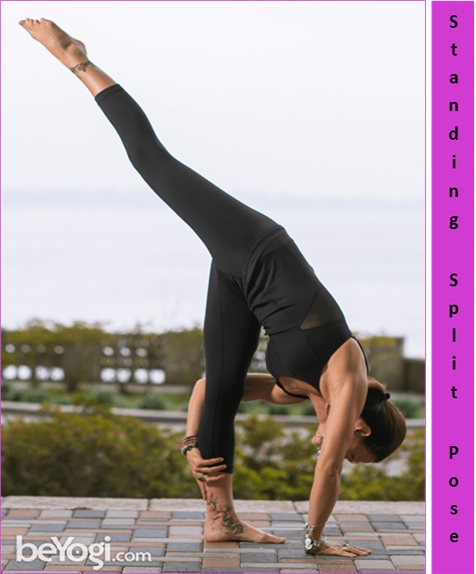
Standing Split Pose
(Urdhva Prasarita Eka Padasana or standing split pose has many benefits. Strengthens the whole lower body. It lengthens the muscles of the legs, particularly the calves and hamstrings, builds stability in the pelvis and hips and opens the hip flexors. It also calms the brain Stimulates the liver and kidneys Stretches the hamstrings, calves, and thighs Strengthens the thighs, knees, and ankles Stretches the back of the leg, the front thigh and groin -WerIndia)
Urdhva Prasarita Eka Padasana
Pose Type: Forward Bend, Hip Opener, Inversion, Standing
Sanskrit: Urdhva Prasarita Eka Padasana (OORD-vah pra-sa-REE-tah eh-KAH pah-DAHS-anna)
urdhva = upward / prasarita = spread / eka = one / pada = foot
BENEFITS
• Lengthens the hamstring of the standing leg
• Strengthens the quadriceps of the standing leg
• Strengthens glutes, hamstrings and quadriceps on lifted leg
• Improves balance and stability while improving strength in both hip joints
• Releases tension in the cervical spine
CONTRAINDICATIONS
• fki
• Migraine
• Low back pathologies
• Ankle, knee, or hip injury
• Shoulder injury (if taking hands behind back)
HOW TO
1. Start in Adho Mukha Svanasana (Downward-Facing Dog).
2. Inhale, look between your hands, and step your right foot forward.
3. Exhale, press through your right foot to extend your knee, and hinge forward through your hips. elevate your left leg upward, reaching through the toes to extend the knee.
4. Inhale, allow your spine to lengthen, and reach through your lifted leg.
5. Exhale and draw the abdominals inward. Begin to round the upper spine and draw your crown toward your toes. Release the hands to the thigh, shin, ankle, or floor. Feel free to keep a microbend at the knee.
6. Hold this pose for up to 5-10 slow breaths.
7. To exit, inhale and draw your hands to your hips while extending the spine. Press through your feet to rise to Tadasana (Mountain pose). Exhale and release your arms to your sides or into Uttanasana (Standing Forward Fold).
MODIFY OR REPLACE
• Feel free to keep a slight bend in the knee to avoid hyperextension.
• Place hands at the thigh, hips, or heart center.
SEQUENCING TIPS
Before:
1. Virabhadrasana III (Warrior 3)
2. Trikonasana (Triangle pose)
3. Parsvottonasana (Pyramid pose)
4. Uttanasana (Standing Forward Bend)
After:
1. Ardha Chandrasana (Balancing Half Moon)
2. Standing Forward Bend
TEACHING CUES
- Keep the upper and lower spine extended and, if choosing to round, only round the upper spine.
- Keep hips stacked equally side by side, engaging the front of the thighs.
- Hinge first at the hips and keep the abdominals drawn up and in toward the spine.
- On each inhale, feel your chest expand and spine lengthen. On each exhale, hinge deeper and send the toes upward
VARIATIONS
- Place arms in Reverse Namaskar.
- Clasp elbows or fingers behind the back.
- Reach down for the ankle.
WATCH OUT FOR
- Rounding the low back instead of hinging at the hips
- Rotating the standing knee inward instead of straight ahead
- Hips angled to one side instead of stacked side by side
This article and image is published here with permission from https://beyogi.com/
Author: HealthyLife | Posted on: August 1, 2022






















Write a comment